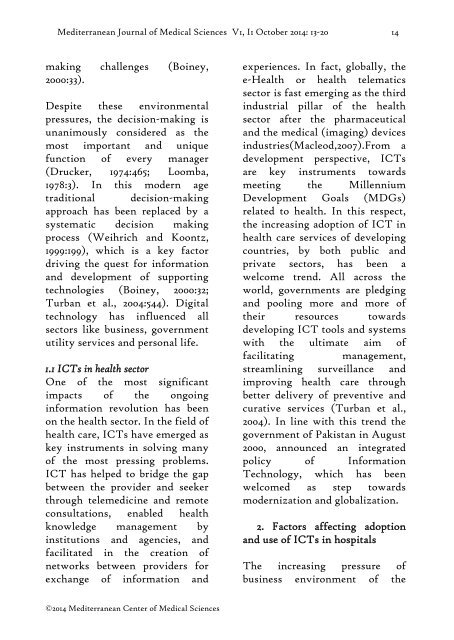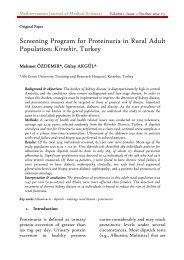Factors affecting the introduction of ICTs for ‘healthcare decision-making’ in hospitals of developing countries
Background & objectives: Several studies have evaluated the impacts of ICTs on decisionmaking process in both public and private health organizations but there is a dearth of such studies that integrate ICTs and effective decision making in Pakistan. Since the Pakistani governments continue to provide huge IT investment for its designated e-government agencies, the need to comprehend the impacts of ICTs on effective decision making becomes more important. Methods: This study strives to ameliorate the comprehension of the impacts of ICTs for decision-making process at all management levels of both public and private health organizations in Pakistan. Research on the information and communication technologies for decision-making is tabling new tools and techniques in the marketplace. Results: This study attempts to unearth literature review-based definition of the local decision-situations to help private and public sector organizations in Pakistan. Interpretation & conclusion: In the emerging ICTs environment, IT elements such as e-mail and group support facilities improve the coordination among the members of an organization in decision making. The use of these ICTs improves the organizational communication, which ultimately leads to effective decision-making Key words: ICTs; adoption factors; decision-making; healthcare; developing countries.
Background & objectives: Several studies have evaluated the impacts of ICTs on decisionmaking
process in both public and private health organizations but there is a dearth of such
studies that integrate ICTs and effective decision making in Pakistan. Since the Pakistani
governments continue to provide huge IT investment for its designated e-government
agencies, the need to comprehend the impacts of ICTs on effective decision making becomes
more important.
Methods: This study strives to ameliorate the comprehension of the impacts of ICTs for
decision-making process at all management levels of both public and private health
organizations in Pakistan. Research on the information and communication technologies for
decision-making is tabling new tools and techniques in the marketplace.
Results: This study attempts to unearth literature review-based definition of the local
decision-situations to help private and public sector organizations in Pakistan.
Interpretation & conclusion: In the emerging ICTs environment, IT elements such as e-mail
and group support facilities improve the coordination among the members of an organization
in decision making. The use of these ICTs improves the organizational communication, which
ultimately leads to effective decision-making
Key words: ICTs; adoption factors; decision-making; healthcare; developing countries.
Create successful ePaper yourself
Turn your PDF publications into a flip-book with our unique Google optimized e-Paper software.
Mediterranean Journal <strong>of</strong> Medical Sciences V1, I1 October 2014: 13-20 14<br />
mak<strong>in</strong>g challenges (Bo<strong>in</strong>ey,<br />
2000:33).<br />
Despite <strong>the</strong>se environmental<br />
pressures, <strong>the</strong> <strong>decision</strong>-mak<strong>in</strong>g is<br />
unanimously considered as <strong>the</strong><br />
most important and unique<br />
function <strong>of</strong> every manager<br />
(Drucker, 1974:465; Loomba,<br />
1978:3). In this modern age<br />
traditional <strong>decision</strong>-mak<strong>in</strong>g<br />
approach has been replaced by a<br />
systematic <strong>decision</strong> mak<strong>in</strong>g<br />
process (Weihrich and Koontz,<br />
1999:199), which is a key factor<br />
driv<strong>in</strong>g <strong>the</strong> quest <strong>for</strong> <strong>in</strong><strong>for</strong>mation<br />
and development <strong>of</strong> support<strong>in</strong>g<br />
technologies (Bo<strong>in</strong>ey, 2000:32;<br />
Turban et al., 2004:544). Digital<br />
technology has <strong>in</strong>fluenced all<br />
sectors like bus<strong>in</strong>ess, government<br />
utility services and personal life.<br />
1.1 <strong>ICTs</strong> <strong>in</strong> health sector<br />
One <strong>of</strong> <strong>the</strong> most significant<br />
impacts <strong>of</strong> <strong>the</strong> ongo<strong>in</strong>g<br />
<strong>in</strong><strong>for</strong>mation revolution has been<br />
on <strong>the</strong> health sector. In <strong>the</strong> field <strong>of</strong><br />
health care, <strong>ICTs</strong> have emerged as<br />
key <strong>in</strong>struments <strong>in</strong> solv<strong>in</strong>g many<br />
<strong>of</strong> <strong>the</strong> most press<strong>in</strong>g problems.<br />
ICT has helped to bridge <strong>the</strong> gap<br />
between <strong>the</strong> provider and seeker<br />
through telemedic<strong>in</strong>e and remote<br />
consultations, enabled health<br />
knowledge management by<br />
<strong>in</strong>stitutions and agencies, and<br />
facilitated <strong>in</strong> <strong>the</strong> creation <strong>of</strong><br />
networks between providers <strong>for</strong><br />
exchange <strong>of</strong> <strong>in</strong><strong>for</strong>mation and<br />
experiences. In fact, globally, <strong>the</strong><br />
e-Health or health telematics<br />
sector is fast emerg<strong>in</strong>g as <strong>the</strong> third<br />
<strong>in</strong>dustrial pillar <strong>of</strong> <strong>the</strong> health<br />
sector after <strong>the</strong> pharmaceutical<br />
and <strong>the</strong> medical (imag<strong>in</strong>g) devices<br />
<strong>in</strong>dustries(Macleod,2007).From a<br />
development perspective, <strong>ICTs</strong><br />
are key <strong>in</strong>struments towards<br />
meet<strong>in</strong>g <strong>the</strong> Millennium<br />
Development Goals (MDGs)<br />
related to health. In this respect,<br />
<strong>the</strong> <strong>in</strong>creas<strong>in</strong>g adoption <strong>of</strong> ICT <strong>in</strong><br />
health care services <strong>of</strong> develop<strong>in</strong>g<br />
<strong>countries</strong>, by both public and<br />
private sectors, has been a<br />
welcome trend. All across <strong>the</strong><br />
world, governments are pledg<strong>in</strong>g<br />
and pool<strong>in</strong>g more and more <strong>of</strong><br />
<strong>the</strong>ir resources towards<br />
develop<strong>in</strong>g ICT tools and systems<br />
with <strong>the</strong> ultimate aim <strong>of</strong><br />
facilitat<strong>in</strong>g management,<br />
streaml<strong>in</strong><strong>in</strong>g surveillance and<br />
improv<strong>in</strong>g health care through<br />
better delivery <strong>of</strong> preventive and<br />
curative services (Turban et al.,<br />
2004). In l<strong>in</strong>e with this trend <strong>the</strong><br />
government <strong>of</strong> Pakistan <strong>in</strong> August<br />
2000, announced an <strong>in</strong>tegrated<br />
policy <strong>of</strong> In<strong>for</strong>mation<br />
Technology, which has been<br />
welcomed as step towards<br />
modernization and globalization.<br />
2. <strong>Factors</strong> <strong>affect<strong>in</strong>g</strong> adoption<br />
and use <strong>of</strong> <strong>ICTs</strong> <strong>in</strong> <strong>hospitals</strong><br />
The <strong>in</strong>creas<strong>in</strong>g pressure <strong>of</strong><br />
bus<strong>in</strong>ess environment <strong>of</strong> <strong>the</strong><br />
©2014 Mediterranean Center <strong>of</strong> Medical Sciences








